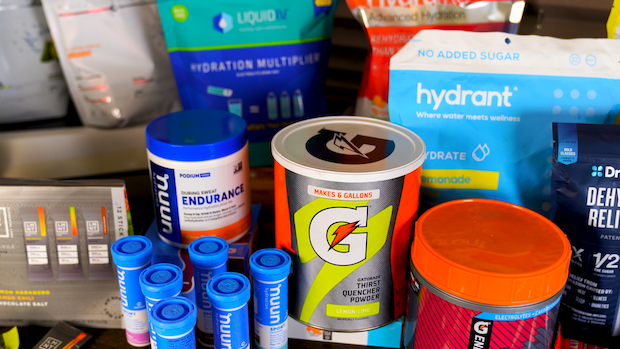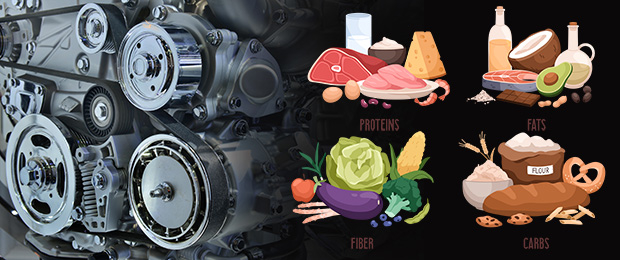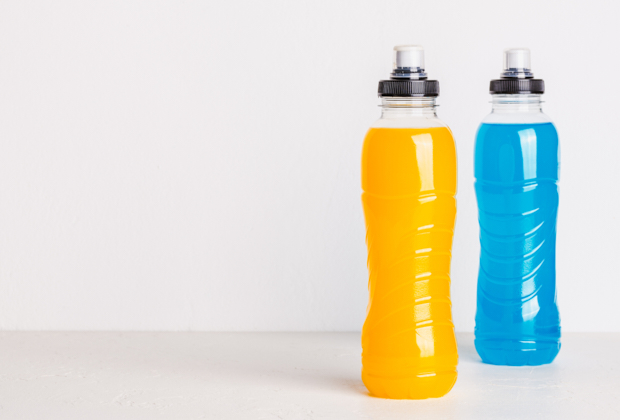Sports Nutrition 101: The Necessity of Carbs

Last article we looked at body systems, and imagined your car with a 5-gallon bucket duct taped to the hood that when spilled could set you ablaze. That bucket represents your gut while you race and train. That article and the bucket analogy might be useful to fully understand before embarking on this article and the rest in this series, where I hope to walk you along the path of greater understanding in how to fuel endurance training and racing. Specifically, how to fuel during training and racing.
One of the most important things in endurance sports is knowing how much of what to put in that auxiliary tank. Let’s first take a look at what those energy sources are.
You use primarily 3 fuels.
–Proteins
–Fats
–Carbohydrates (or Carbs for short)
Remember, it is with this finicky fueling system that we humans operate. We have limited onboard fuel (carbs), a poor secondary fuel (fats) which work only for slow driving, or only provide a portion of the energy we need for faster driving, and a small auxiliary fuel tank (the 5-gallon-bucket-on-the-hood) that is as finicky as you can imagine, which has only a tiny hose to send fuel to our engine (muscles). And the faster we drive, the more perilous it becomes.

Okay, back to reality for a second. Carbs are the most efficient fuel for exercise. There is no debate at this point. But your tanks are limited. Fats are slow and inefficient.
If you’re asking about protein as fuel, don’t. It’s a terrible fuel and you have to break down other tissues in your body to use it as fuel, and there’s no internal storage tank for it that’s not doing something else functionally (like contracting your heart or muscles). For the purposes of the fueling discussion, until we get into really niche discussions about amino acids and brain cognition, we’ll just leave protein out, for simplicity’s sake.
Most folks talk of energy in terms of calories. That’s scientifically correct. But if you’re driving that car with the bucket on the hood, while you could put any number of things in it, my bet is that you’re going to put the fuel in it that fuels your engine efficiently and doesn’t gum things up.
That’s carbs. It turns out, fats operate a lot like if you put corn oil in that duct taped bucket on your hood. They slow down the flow through the little hose.
Physiology reminder: we call that flow: “absorption.” Absorption is the flow of fuel from your small intestine (5-gallon bucket), through its walls and cellular lining (coffee-straw sized hose), into your blood vessels (fuel lines) pumped by your heart (fuel pump).
Once the stuff that is absorbed is then pulled up into the muscles, from the blood vessels, we call it “uptake.” Ironically and very confusingly, you’ll also hear absorption called uptake, depending on the context.
Here’s what you can take to the bank: Intake always means the stuff that goes into your mouth. Uptake can sometimes mean “taken up by your blood, from your gut” or can sometimes mean “taken up from the blood, by another tank or system, like your muscles.” If you’re confused, check the context, and know that “uptake” is always used to mean “going to the next step in the system.” I’ll try to keep “uptake” in my writing, strictly to that which goes from the blood vessels to the muscles, and “absorption” always meaning that which goes from gut to the blood.

It goes like this:
1. Intake (in your mouth)
2. Absorption (gut to blood)
3. Uptake (blood to something else, probably muscles during exercise)
4. Burn or Store for later. But during exercise, you won’t be doing any storage. So it’s just burning.
As I mentioned earlier, one of the most important things in endurance sports is knowing how much of what to intake. That is, what and how much do we put into that finicky auxiliary tank. And to learn about that, you’re going to need to speak the same language as the instructor. So let’s talk about that language for a moment. We need to quantify things, which can sometimes be mind-numbingly boring, but is definitely worth doing! When you’ve got a system as fickle and delicate as ours, and when you’re trying to push it to peak performance, some quantifying is a really good idea until your intuition can take over again.
How do we quantify the energy in the fuel? How do we talk about how much fuel we’re consuming? We can talk about calories, grams, gels, chews, bottles, ounces, the sky's the limit. These things matter. Let’s dig into an example.
Let’s do another analogy and think about gasoline again for a second. We could quantify gasoline in terms of how much energy it provides. We could say: I filled my tank with 300 megajoules. And maybe that would be a good way of quantifying fuel if every time we put gas in our tanks we were mixing 3 different things, like methane, gasoline, and motor oil. But since we’re just being sensible and using gasoline in our car, we just say how much gas we’re putting in. We say “gallons of gas” (or liters of gas for our metric friends). It’s just easier.
It’s also more accurate, because we don’t really want methane or oil mixed with our gas. Even if you know nothing about methane, and how it relates to car gasoline, (it doesn’t) you don’t want it mixed. You just want gas in your car. No methane. No other stuff that’s not supposed to be gas. (yes, I had to google some of this because I’m not a car guy.)
But, let’s run with the methane and gas analogy for a second. According to Dr. Google, methane has more energy per gram than gasoline, much the same as fat having more energy per gram than carbs.
Just because methane has more energy per gram, doesn’t mean we want it in the fuel we put in our car and certainly we don’t want to count its energy towards what we’re paying for at the pump. That would be a waste. Nor do we want to count methane towards what the car is burning. Assuming it didn’t make our car explode, it will be taking up some of the space in our gas tank, and we’d prefer to just have a full tank of gas. The same can be said about our own fuel tanks during exercise.
The key point is, the wrong fuel type won’t burn well or safely, and we don’t want to spend resources on it. Gut resources or monetary ones.
Similarly, adding fats to workout fuel only dilutes and slows the fuel you can consume and absorb, and doesn’t increase the amount of fat you can burn during exercise. So, akin to how you might not want to count (or pay for) methane in your gasoline, it might not be sensible to count calories from the fat in your workout fuel when you’re trying to figure out what to intake. It’s not increasing your engine’s (muscles’) energy availability.
We want gasoline in our cars. We measure gasoline in gallons. Not megajoules.
We want carbohydrates in our workout fuel. We measure carbohydrates in grams. Not calories.
With the understanding that what I’m about to petition you for is an enormous request, and departure from what many in the industry are doing, I’ll encourage you to think with me about how many grams of carbs you consume during exercise, and not how many calories anymore.
Ironically, much of the endurance coaching industry still talks in terms of calories per hour during endurance activity. It’s like pretending that you could put a mix of methane, oil, and gasoline in your car’s fuel tank, and get the same result as an energetically equivalent amount of gasoline. You would not. You’d get a gummed up fuel line from the tank to the engine.
You wouldn’t put used oil in your gas tank. Don’t put fiber, fat and protein in your gas tank while you train. And if you do, certainly stop counting them towards your calorie hourly intake because they’re really not contributing to the fuel you’re actually burning during exercise. And, they might be slowing down your system.
Here is a crash course you can refer back to, if you ever need reference to terms, or want to crunch some numbers, just for fun’s sake.
Carbs ? 4.1 kcal/g, but 4 is good enough and works better for many simple sugars.
Fats ? 9.1 kcal/g, but is sometimes 10, sometimes 9.4. Don’t sweat it.
Protein ? 4.1 kcal/g, but 4 is good enough here, too.
Alcohol = 7 kcal/g, but you definitely don’t need it during training. 😉
Fiber = 0 kcal/g. Doesn’t have meaningful calories, so 0 is close enough.
Sugar alcohols ? 2 kcal/g but they don’t fuel exercise well. If you see this in workout fuel, run away. Probably don’t need to know any more than that about these.
Artificial sweeteners are used in such small amounts that their kcal contribution is basically 0. Vitamins & minerals are also used in tiny quantities so even if they have calories, they’re still 0 in the grand scheme of things.
Let’s cover a couple more terms you’ll almost certainly read me using in my writing. If you intake carbs, and those carbs go through all four steps of intake, absorption, uptake, and then you burn them, those carbs are considered part of your exogenous carb burn. If you had some carbs in your muscle tank before exercise, and you burned those too, those internal ones would be part of your endogenous carb burn.
Exogenous just means, “came from outside your body,” and endogenous means, “came from within.” If the carbs started inside your body at the beginning of your workout, they’re endogenous. If they came from outside your body during the workout, like from your bike bottles, they’re exogenous to you.
When both of those are burned, they’re “oxidized,” which is just a fancy word to mean “burned.” Chemists just like fancy words, and then they get lodged in my brain and come out in my writing. You can always read “burn” and “oxidized” synonymously.
Another fancy word before we embark on the rest of the more exciting informational content is “gastrointestinal tract” also sometimes called “GI” for short. It just means “your gut.” It includes your stomach, and your small intestine, where absorption happens, and your lower intestine, where not much absorption happens, but which can sometimes be weaponized against your performance if your upper GI isn’t happy with you. Confusingly: GI can also mean Glycemic Index, ie how fast a carb gets absorbed into blood. This is another “check your context” situation. I’ll try to make my meaning plain, as I go.
Handy definitions
Intake: What you put in your face hole. Can be consumed via drink, gel, chew, or anything else you like. Add it all up, and that’s your intake during your training and racing.
Absorb / Absorption – What goes from your gut into your bloodstream.
Uptake: Sometimes confusingly used to mean the same thing as absorption, and other times to mean what goes from the blood to the muscle or liver. Generally means in lay person articles about nutrition that the nutrients are going one level deeper into your body…which is what you want.
GI – Can mean “Glycemic Index,” as in how fast a carb raises your blood sugar, or “Gastrointestinal,” ie your guts. “GI issues” usually refers to “doubled over in pain because stomach hurts” or “need to find the nearest toilet, asap.” The “GI of a carb” refers to the specific numerical value calculated for that carbohydrate. Context is important here.
Burn / Oxidation: How much carbs are being used to make energy.
Endogenous: From within your body. Usually in reference to fat or carb stores that were in your body before the race started.
Exogenous: From outside your body. A typical usage: Her exogenous carb burn was only 56 grams per hour, because she only consumed 65 grams per hour (you won’t always burn everything you eat, because we’re human, and being human comes with a little inefficiency).
In summary here’s a little exercise for your brain. If you can read the following sentence, then you’re probably well-prepared to jump into the upcoming articles in this series. Give it a shot below.
“Exogenous refers to fuel you intake, then absorb, uptake, and then burn, hopefully without GI issues because you’re using a high GI carb source.”
If you were able to read that, you just understood a sentence with at least six new terms in it. Kudos for battling your way through my writing. Next time, I hope we can come together and learn a bit more about how to use some of these terms to your advantage, and spend less time in the terminology weeds. This concludes our seminar in terminology. Join me next time to apply some of this to actually going faster and feeling better in training.


Start the discussion at slowtwitch.northend.network